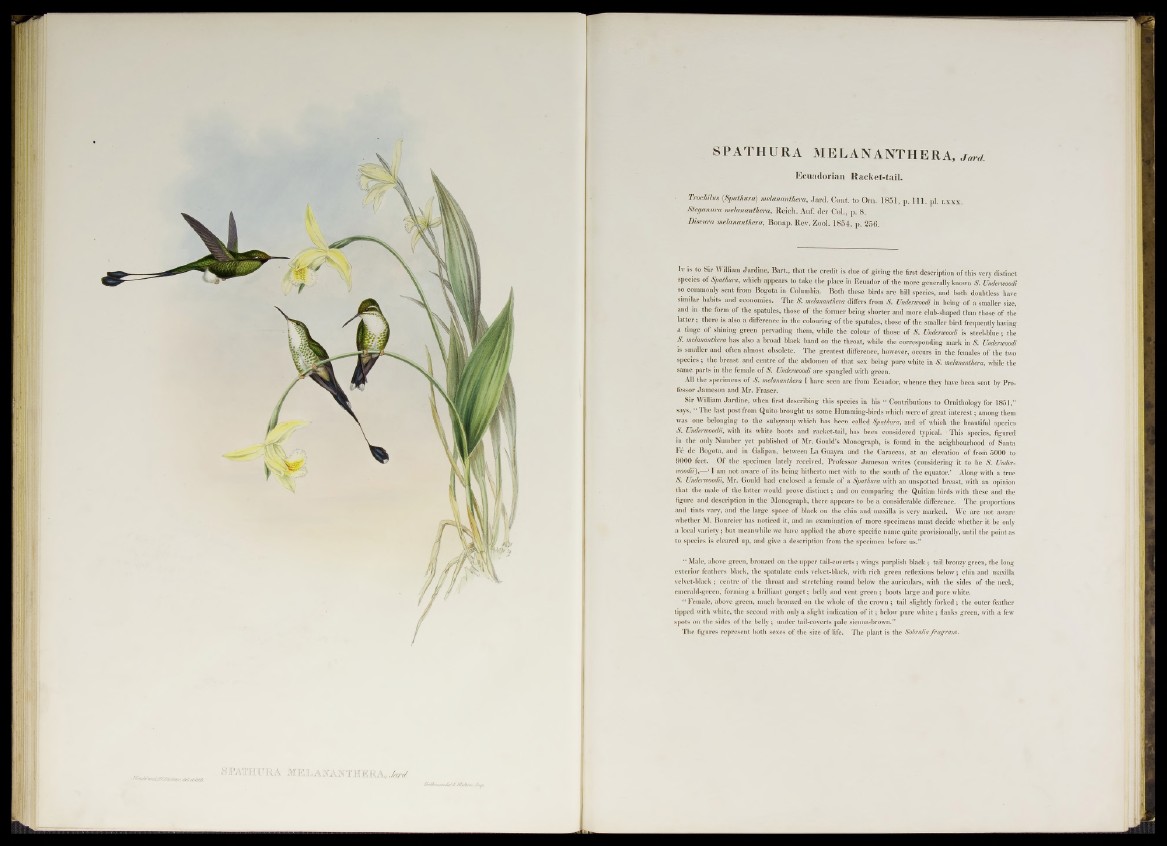
mm
JGouM«ndJrCJfyakier, e&i (¿¿¿(A SPATHURA MEJL-ANANTJBTERA, Jard.
JSMmvuiU* WWi fMi
SPATHURA MELANANTHERA, j a r d .
Ecuadorian Racket-tail.
Trochilus (Spathura) melananthera, Jard. Cont. to Om. 1851, p . 111. p i. l x x x .
Steganura melananthera, Reich. Auf. der Col., p. 8.
Discara melananthera, Bonap. Rev. Zool. 1854, p. 256.
It is to Sir William Jardine, Bart., that the credit Is due of giving the first description of this very distinct
species of Spathura, which appears to take the place in Ecuador of the more generally known S. Undermodi
so commonly sent from Bogota in Columbia. Both these birds are hill species, and both doubtless have
similar habits and economies. The S. melananthera differs from S. Underuioodi in being of a smaller size,
and in the form of the spatules, those of the former being shorter and more club-shaped than those of the
latter; there is also a difference in the colouring of the’spatules, those of the smaller bird frequently having
a tinge of shining green pervading them, while the colour of those of S. Underwoodi is steel-blue; the
S. melananthera has also a broad black band on the throat, while the corresponding mark in S. Underwood.i
is smaller and often almost obsolete. The greatest difference, however, occurs in the females of the two
species ; the breast and centre of the abdomen of that sex being pure white in S. melananthera, while the
same parts in the female of S. Underwoodi are spangled with green.
Ail the specimens of S. melananthera I have seen are from Ecuador, whence they have been sent by Pro-
fessor Jameson and Mr. Fraser.
Sir William Jardine, when first describing this species in his “ Contributions to Ornithology for 1851,”
says, “ The last post from Quito brought us some Humming-birds which were of great interest; among them
was one belonging to the subgroup which has been called Spathura, and of which the beautiful species
S. Undej-tooodii, with its white boots and racket-tail, has been considered typical. • This species, figured
in the only Number yet published of Mr. Gould’s Monograph, is found in the neighbourhood of Santa
Fe de Bogota, and in Galipan, between La Guayra and the Caraccas, at an elevation of from 5000 to
9000 feet. Of the specimen lately received, Professor Jameson writes (considering it to be S. Under-
woodii),—11 am not aware of its being hitherto met with to the south of the equator.’ Along with a true
S. Undermodii, Mr. Gould had enclosed a female of a Spathura with an unspotted breast, with an opinion
that the male of the latter would prove distinct; and on comparing the Quitian birds with these and the
figure and description in the Monograph, there appears to be a considerable difference. The proportions
and tints vary, and the large space of black on the chin and maxilla is very marked. We are not aware
whether M. Bourcier has noticed it, and an examination of more specimens must decide whether it be only
a local variety; but meanwhile we have applied the above specific name quite provisionally, until the point as
to species is cleared up, and give a description from the specimen before us.”
“ Male, above green, bronzed on the upper tail-coverts ; wings purplish black ; tail bronzy green, the long
exterior feathers black, the spatulate ends velvet-black, with rich green reflexions below; chin and maxilla
velvet-black ; centre of the throat and stretching round below the auriculars, with the sides of the neck,
emerald-green, forming a brilliant gorget; belly and vent green ; boots large and pure white.
“ Female, above green, much bronzed on the whole of the crown ; tail slightly forked ; the outer feather
tipped with white, the second with only a slight indication of i t ; below pure white ; flanks green, with a few
spots on the sides of the belly ; under tail-coverts pale sienna-brown.”
The figures represent both sexes of the size of life. The plant is the Sobi'alia fragrans.